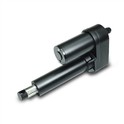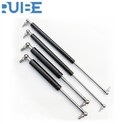Tensile strength is a critical mechanical property that measures the maximum amount of tensile (pulling) stress a material can withstand before failure. When it comes to Bonnet Gas Springs, understanding their tensile strength is crucial for various applications, from automotive bonnets to industrial machinery. As a leading Bonnet Gas Spring supplier, we are well - versed in the technical aspects of these components and are here to shed light on their tensile strength.
The Basics of Bonnet Gas Springs
Bonnet Gas Springs are a type of gas - filled cylinder that uses compressed gas to provide a lifting or counterbalancing force. They are commonly used in automotive applications to support the bonnet, making it easier to open and close. These springs consist of a cylinder, a piston rod, and a gas chamber filled with nitrogen gas under high pressure.
The design of Bonnet Gas Springs is engineered to ensure smooth operation and reliable performance. The gas inside the cylinder exerts a force on the piston, which in turn provides the necessary lifting power. However, the spring must also be able to withstand the forces acting upon it, including tensile forces.
Understanding Tensile Strength in Bonnet Gas Springs
Tensile strength in Bonnet Gas Springs refers to the maximum pulling force that the spring can endure without breaking or deforming permanently. This property is determined by several factors, including the material of the cylinder and piston rod, the design of the spring, and the manufacturing process.
Material Selection
The choice of materials plays a significant role in determining the tensile strength of a Bonnet Gas Spring. High - quality steel is commonly used for the cylinder and piston rod due to its excellent mechanical properties. Steel offers high strength, good corrosion resistance, and the ability to withstand high pressures. For example, stainless steel is often preferred in applications where the spring will be exposed to harsh environmental conditions, as it resists rust and corrosion, which can weaken the material over time.


Design Considerations
The design of the Bonnet Gas Spring also affects its tensile strength. The diameter of the piston rod, the wall thickness of the cylinder, and the overall length of the spring all contribute to its ability to withstand tensile forces. A thicker piston rod and cylinder wall can generally handle higher tensile loads. Additionally, the design of the end fittings, which connect the spring to the bonnet and the vehicle frame, must be robust enough to transfer the forces without failure.
Manufacturing Process
The manufacturing process is another crucial factor in determining the tensile strength of Bonnet Gas Springs. Precision machining is used to ensure that the components are made to the exact specifications. Heat treatment processes can also be applied to enhance the strength and hardness of the materials. For example, quenching and tempering can improve the mechanical properties of the steel, making it more resistant to deformation and fracture.
Importance of Tensile Strength in Different Applications
Automotive Applications
In automotive applications, the tensile strength of Bonnet Gas Springs is of utmost importance. The spring must be able to support the weight of the bonnet and withstand the forces generated during opening and closing. If the tensile strength is insufficient, the spring may break or deform, leading to safety hazards and a loss of functionality. For instance, a broken gas spring could cause the bonnet to fall unexpectedly, potentially causing injury to the user or damage to the vehicle.
Industrial Applications
In industrial settings, Bonnet Gas Springs are used in a variety of machinery and equipment. They are often required to support heavy loads and operate under high - stress conditions. For example, in manufacturing plants, gas springs may be used to open and close large access panels or doors. In these applications, a high tensile strength is essential to ensure reliable and safe operation.
Measuring Tensile Strength
The tensile strength of Bonnet Gas Springs is typically measured in units of force per unit area, such as Newtons per square millimeter (N/mm²) or pounds per square inch (psi). To determine the tensile strength, samples of the spring components are tested in a laboratory using a tensile testing machine. The sample is gradually pulled until it fails, and the maximum force applied is recorded.
Our Offerings as a Bonnet Gas Spring Supplier
As a Bonnet Gas Spring supplier, we offer a wide range of products with different tensile strengths to meet the diverse needs of our customers. Our springs are manufactured using high - quality materials and advanced manufacturing processes to ensure superior performance and reliability.
We understand that different applications require different levels of tensile strength. That's why we work closely with our customers to understand their specific requirements and provide customized solutions. Whether you need a gas spring for a small car bonnet or a heavy - duty industrial application, we have the expertise and resources to deliver the right product.
Related Products
In addition to Bonnet Gas Springs, we also offer a variety of other gas springs for different applications. For example, we have Gas Spring for Tanning Bed, which are designed to provide smooth and reliable operation for tanning beds. Our Murphy Bed Gas Spring is ideal for folding beds, offering the necessary support and ease of use. And our Gas Spring for Tool Box is perfect for tool boxes, ensuring that they can be opened and closed effortlessly.
Contact Us for Procurement
If you are in the market for Bonnet Gas Springs or any of our other gas spring products, we invite you to contact us for procurement. Our team of experts is ready to assist you in selecting the right product for your application. We can provide detailed technical information, offer samples for testing, and work with you to ensure a smooth purchasing process. Whether you are an automotive manufacturer, an industrial equipment supplier, or a DIY enthusiast, we have the products and expertise to meet your needs.
References
- Callister, W. D., & Rethwisch, D. G. (2012). Materials Science and Engineering: An Introduction. Wiley.
- Shigley, J. E., Mischke, C. R., & Budynas, R. G. (2004). Mechanical Engineering Design. McGraw - Hill.






